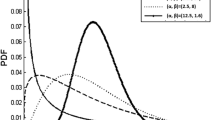Abstract
Many statistical methods applied to manufacturing quality control and operations management have been under the assumption that the process characteristic investigated is normally distributed. If the process characteristic is not normally distributed, a popular approach is to transform the non-normal data into a normal one. In this paper, we consider the Box-Cox transformation, and compare the transformation power using two different parameter estimation methods, including the maximum likelihood estimator (MLE) and the method of percentiles (MOP). The performance comparison is based on the pass rate under the Shapiro-Wilk normality test. The results show that, in general, the MOP has better pass rate, while the MLE has smaller power variation for most cases investigated. For small sample size (n=5, 10) both methods perform equally well. For large sample size, the MOP is recommended due to its simplicity and significantly higher pass rate.
Similar content being viewed by others
References
Box GEP, Cox DR (1964) An analysis of transformations. J Roy Stat Soc B 26:211–252
Draper NR, Cox DR (1969) On distributions and their transformations to normality. J Roy Stat Soc B 31:472–476
Han AK (1987) A non-parametric analysis of transformation. J Econometrics 35:191–209
Hernandes F, Johnson RA (1980) The large sample behavior of transformation to normality. J Am Stat Assoc 75:855–861
Hinkley DV (1975) On power transformations to symmetry. Biometrika 62(1):101–111
Hinkley DV (1976) On quick choice of power transformation. Appl Stat 26(1):67–69
Madansky A (1988) Prescriptions for working statisticians. Springer, New York
Ogwang T, Gouranga Rao UL (1997) A simple algorithm for estimating Box-Cox models. Statistician 46(3):399–409
Pyzdek T (1995) Why normal distributions aren’t [all that normal]. Qual Eng 7(4):767–777
Schlesselman J (1971) Power families. A note on the Box-Cox transformation. J Roy Stat Soc B 33:307–371
Shapiro SS, Wilk MB (1965) An analysis of variance test for normality. Biometrika 52(3–4):591–611
Taylor JMG (1985) Power transformations to symmetry. Biometrika 72(1):145–152
Tukey JW (1957) The comparative anatomy of transformations. Ann Math Stat 28:602–632
Author information
Authors and Affiliations
Corresponding author
Rights and permissions
About this article
Cite this article
Chung, S.H., Pearn, W.L. & Yang, Y.S. A comparison of two methods for transforming non-normal manufacturing data. Int J Adv Manuf Technol 31, 957–968 (2007). https://doi.org/10.1007/s00170-005-0279-3
Received:
Accepted:
Published:
Issue Date:
DOI: https://doi.org/10.1007/s00170-005-0279-3




